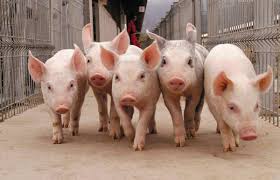for livestock breeding BELPLEMZHIVOBEDINENIE
Dairy farming
The republic's dairy cattle breeding is represented by the Belarusian black-motley cattle breed, which has a high genetic productivity potential. Cattle of this breed is practically the only source of milk and beef in the republic.
Read moreBeef cattle
The system of pedigree work in cattle breeding of the republic provides for the bulk of beef to be obtained from dairy and combined cattle and industrial crossbreeding of planned cows with specialized bulls.
Read morePig breeding
In the Republic of Belarus, there are 2.9 million heads of pigs in all categories of farms, including 2.5 million in agricultural organizations, of which 290 thousand in pedigree farms.
Read moreHorse breeding
There are about 34 thousand horses in the republic. Despite the small share (about 5%), the basis of the industry is the breeding direction of the use of horses. Currently, 18 pedigree agricultural enterprises for horse breeding are certified and operate.
Read moreSheep breeding
Sheep breeding as one of the branches of animal husbandry has always been an integral part of the country's national economic complex. Currently, sheep breeding in Belplemzhivobedinenie is represented by RUE “Vitebsk breeding enterprise” where there are 772 heads (adults and young animals) of Romanov breed sheep.
Read moreEmbryo transplantation
One of the most important sources of accelerated obtaining of high-value offspring from outstanding breeding animals is embryo transplantation.
Annually, more than 100 calf grafts are received at Belplemzhivobedineniy enterprises.
Dairy Labs
An indispensable condition for the implementation of the breeding programs of the republic is the availability of modern laboratories for the comprehensive analysis of the quality indicators of milk for the content of fat, protein and somatic cells. There are currently 6 such laboratories in the republic - one in each region.
Read moreBelplemzhivobedinenie always ready for fruitful and mutually beneficial cooperation will assist in the sale of breeding young farm animals and their products.
Pig breeding in the world. China

Currently, the pig market in China is monopolized by imported breeds. At the same time, according to statistics, there are about 48 local pig breeds in the country.
Chinese breeds are perfectly adapted to the use of roughage and local climatic conditions, are distinguished by early puberty.
However, the slow growth rate and the low percentage of meat in the carcass significantly reduce the possibility of profit from breeding local pigs, although the quality and taste of pork are good.
To improve the growth energy and meat qualities of Chinese pig breeds, a gene editing method has recently been used. Gene editing is a technology that enables accurate genomic modifications of a target gene.
Compared to traditional breeding methods, gene editing technology has advantages: a very short propagation time of the desired traits within the population, stable transmission of traits, and saving labor and material resources.
Currently, three gene editing technologies have been studied in China. Chinese biotechnology has chosen ZFN technology as the most advanced method, and is used for widespread use.
It has been experimentally established that mutations in the MSTN gene lead to muscle hypertrophy or the double muscle phenotype (DM) in cattle, sheep, dogs, and humans. But there was no information on significant muscle phenotypes associated with mutations in the MCN gene in pigs.
For the experiment was chosen to breed Meishan (Ms), which is characterized by high fertility, but has a high percentage of fat in the carcass and high feed conversion. The mutant was derived piglets using cloning mutant cells manually.
In the result of comparative analysis of animal carriers of mutant MSTN gene and not the mutant animals breed Meishan found that the square muscle of the eye from the representatives of the carriers of the mutant gene – 56,4 cm, and the animals breed Meishan - 26,3 cm; the percentage of meat in the carcass 61,2% and 44.6%, respectively.
in addition, about 20% of the mutant pigs had one additional thoracic vertebra, which allowed to increase the length of the body of animals. The results of the analysis of meat quality showed that there are no differences between mutant and not mutant pigs.
Currently, the method of obtaining mutant pigs by genomic modifications of the gene target MSTN patented and has good prospects for use in industrial pig farming China, as a way to improve meat quality of Chinese domestic breeds in bold type.
According to Chinese scientists edit the gene is an inevitable trend of livestock of the future.
According to the Institute of animal husbandry (IAS), Academy of agricultural Sciences of China (CAAS), associate Professor of Venta Kui.
